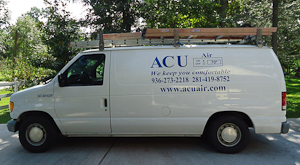Reducing the Risk of Water Damage
While you can't control the weather, you can reduce the risk of water damage from your air conditioning system. Air conditioners produce an astonishing amount of condensation. Without proper maintenance, that condensation may lead to water damage and can even cause ceilings to cave in. Undetected water damage may also foster the growth of mold.
In most cases, the evaporator coil utilized in your air conditioning system is housed in your attic or in a closet. As your air conditioning system operates, the condensation produced by the evaporator coil passes through the unit's main drain line which ties into your plumbing system. In case the main drain should develop a clog, the evaporator coil has an emergency drain pan. An emergency drain runs from this pan to the outside of your house. If you observe water steadily dripping or streaming from a pipe extending out of an upper exterior wall, it is likely that your main drain line is clogged and needs to be cleared. If you do not have the main drain cleared and the emergency drain becomes clogged, as well, water may back up, overflow the drain pan, and seep through your ceiling or run down the inside of a wall.
While a clogged main drain is the most common cause of water damage from an air conditioning system, it is not the only cause. Easily corrected problems like burned contacts on the contactor (located in your condenser unit), dirty coils, or low refrigerant pressure may cause the evaporator coil to work overtime. The evaporator coil may subsequently freeze up and then defrost, releasing more water than your cooling system's main drain and emergency drain can carry away.
Here are some things you can do to reduce the risk of water damage from your air conditioning system:
Have your air conditioner inspected annually. The inspection should include a check of the main drain and emergency drain lines for obstructions, the contactor for burned contacts, the coils to determine whether they need to be cleaned, and the refrigerant pressure. Should the inspection reveal any such problems, you will need to have your equipment serviced or repaired.
When you have your air conditioning system inspected, ask the technician to perform an algaecide treatment. This inexpensive treatment will discourage the growth of algae which is often a culprit in clogged drain lines. Many companies (ACU Air included) perform an algaecide treatment at no extra charge as a routine part of the inspection. Please note that while this treatment will stop the growth of algae, it will not prevent obstructions caused by mineral deposits or by insects or rodents building nests in your drain lines.
Change your air conditioning filter regularly (once a month is ideal) and do not allow tall grass or shrubs to restrict the air flow to your outside condenser unit. Air flow restrictions from dirty filters or from shrubs growing around the condenser will cause your evaporator coil to work longer and harder, increasing the risk of the coil freezing over and defrosting.
If your cooling system has a mechanical media filter, have a technician replace the filter once a year.
If you see water coming out of the emergency drain pipe, shut off your air conditioner and call a service technician.
Have a safety float switch installed. If water accumulates in the drain pan, the float switch will shut off the power to your air conditioner, preventing further condensation. When the air conditioner stops running, the rising temperature inside your home will cue you to call a service technician. Once the technician has identified and corrected the problem that caused water to back up in your drain pan and has cleared the standing water from the pan, the float switch will allow the unit to come back on.
In most cases, regular preventitive maintenance will go a long way towards reducing the risk of water damage from you air conditioner. One exception to this rule is a cooling system with improperly installed evaporator coils, drain pans, or drain lines. These drains depend on gravity to remove condensation. If the equipment or the lines do not slope in the right direction or if the slope is inadequate, condensation may repeatedly accumulate, back up, and over flow. In these cases, it may be necessary for an air conditioning technician to reposition the equipment or the drain pan or rerun the drain lines to provide adequate drainage.
|
(936)-273-2218 | (281)-419-8752 |
 |
 |
 |
 |
|||
| No matter the season, we keep you comfortable | ||||||





